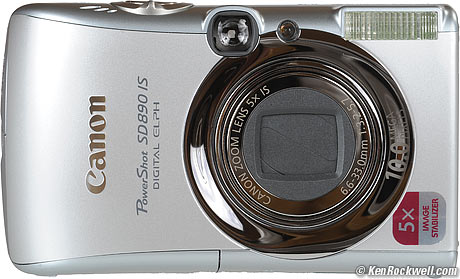Canon
SD890 IS
(IXUS 970 IS)
© 2008 KenRockwell.com. All rights reserved.
Canon SD890 IS. enlarge.
I'd order mine from Adorama or Amazon. It helps me keep adding to this site when you get yours from this link, too.
March 2008
Introduction top
Intro Specs Performance Recommendations
The Canon SD890 is a pocket camera with a 2.5" screen, 5x zoom lens and image stabilization. It is state-of-the-art in 2008.
It stands out because it's tiny enough for a pocket and has a 5x optical zoom lens. It sells for about $350 as of May 2008.
Specifications top
Intro Specs Performance Recommendations
Name: Canon calls this the PowerShot SD890 IS Digital ELPH Camera.
Resolution: 10MP (3,648 x 2,736 pixels), also settable to cropped 3,648 x 2,048 (16:9), 6MP, 4MP, 2 MP and VGA (640 x 480).
Lens: 5x optical zoom, 37-185mm equivalent.
Image Stabilization: YES.
LCD: 2.5."
Peephole Viewfinder: YES.
Battery: NB-5L, 1120 mAh, included.
Charger: CB-2LX, included.
Also Included: An almost useless 32MB SD memory card, a USB interface cable, a video playback cable, a wrist strap, and a software CD.
Announced: 12 March 2008.
Available: Since April 2008
Price: About $350 as of May 2008.

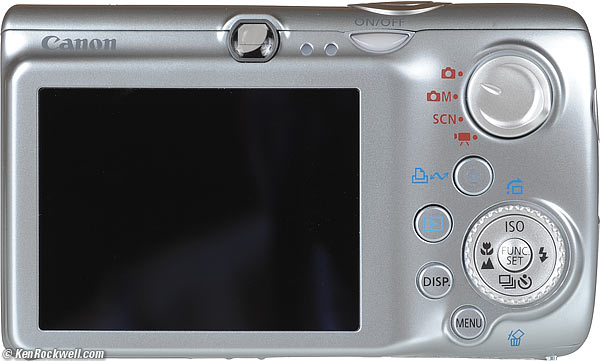

Canon SD890 IS, larger than life.
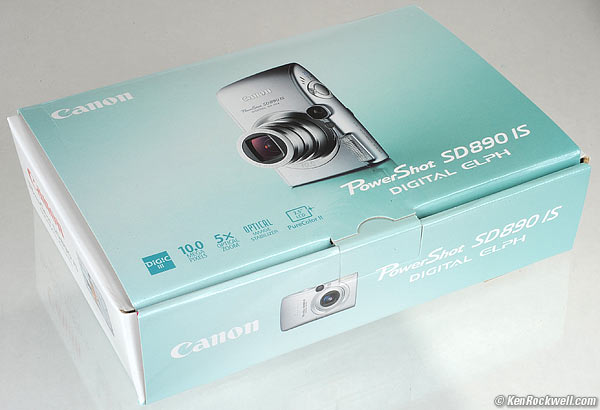
Canon SD890 IS Box.
Performance top
Intro Specs Performance Recommendations
Overall
It's about the same as every other Canon, which is excellent.
LCD
The LCD is excellent by 2005 standards, but puny by 2008's standards.
It's sharp and accurate, but too small for today.
I prefer the less expensive SD790, with its three-dimensional 3" LCD, over this SD890, just for the screen.
Speed
Operational speed is typical for a compact camera. Shutter delay isn't an issue if you use it properly.
Ergonomics
Ergonomics are good, typical of all Canon's compact Powershot cameras. I prefer the power switch of the SD790 over the hard-to-press hidden-in-a-crack power button of this SD890.
I prefer the feel of the less expensive SD790's buttons.
New on the SD790 and this SD890 are that the round four-way control is now a spinning knob!
This works much better on the SD890 than it does on the SD790, but I still prefer clicking buttons over the dial. The dial is still nowhere near as good as it is on Canon's DSLRs like the 40D.
The SD890 has Canon's usual superior controls and features. For instance, you can assign the PRINT button to do your bidding while shooting; I program mine for instant access to exposure compensation. Like Casio, holding the PLAY button now turns on the camera in play mode without extending the lens.
Canon still lags behind Casio; you have to push the PLAY button after a shot to play other images.
Image Quality
Like a typewriter, the quality of what's created has a lot more to do with the photographer than with the camera.
As far as noise and sharpness, technical image quality is the same as most other compact cameras. It's very sharp, but much noisier (grainier) than the images from any digital SLR.
It's clean enough at ISO 80 in daylight, but noisy at ISO 200. This is the way compact digital cameras have been for a long time.
When shooting at smaller resolutions, the SD890 correctly creates images even sharper (pixel-by-pixel) than at larger resolutions. This is because Bayer Interpolation goes away when set to smaller resolutions. I usually shoot at 6MP; 10MP wastes too much file space for me.
Color


Made in "Vivid" mode (exactly as the images came from the SD890).
Colors matches all the other Canon compacts, which means I can create wild, vivid colors if I can find colorful things to photograph.
I like vivid colors, so I set the Vivid mode. You do this by:
1.) Press FUNC. SET.
2.) Click down to OFF.
3.) Click right to Vivid.
4.) Press FUNC.SET to exit.
The SD890 has the usual strong barrel distortion at the wide end and a little pincushion at tele. Every compact camera does this.
If you need to, it's trivial to correct the distortion completely by plugging these figures into Photoshop CS2's lens distortion filter. These aren't facts or specifications, they are the results of my research that requires hours of photography and calculations on the resulting data.
wide |
+5.0 |
tele |
-0.5 |
© 2008 KenRockwell.com. All rights reserved.
Fill Flash (using flash with daylight)
Balance between flash fill and ambient light is better than I've seen before, but compact cameras still aren't great compared to DSLRs.
Typically the backlit background still blows out, with the filled-in foreground OK. You'd have to jack around with exposure compensation to fix this, as with most compacts.
Want perfection? You'll need a Nikon D40 for that, which doesn't cost that much more.
Sharpness
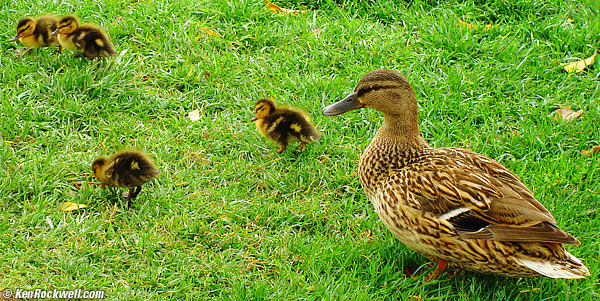
Baby Ducks and Mom, Carlsbad, California. (Cropped; mid-tele setting.)
Its lens and files are very sharp.
Even at macro range, sharpness is limited only by your photographic abilities, not by this camera.
I can make brilliant 12 x 18" prints, or bigger, with no problem, as I can with most compact cameras today.
Macro
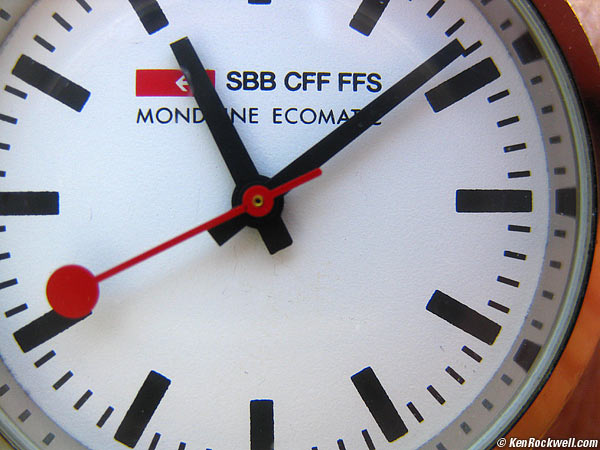
The SD890 gets so close that the biggest problem is not to block your light!
Like most compacts, it gets closer than almost anyone needs.
Image Stabilization (IS)
Image Stabilization (IS) works great.
I've gotten sharp hand-held shots 1/8 second, even at the tele setting!
Panoramic Stitching and QTVRs
You get to the Stitch Assist mode by turning the rear control dial while the selector knob is set to the red camera +M position.
The SD890 comes with free Canon Photostitch v3.2 software which lets you create all sorts of panoramas. I've never bothered with a tripod; I shoot these freehand.
The software lets you create all sorts of outputs. Have fun!
Battery Life
There is a three-segment battery-charge indicator on the LCD (press DISP a couple of times if you can't see it).
I used the SD890 for over a week, made over 450 shots and videos and spent plenty of time playing in the menus and playing images and kid videos. The battery gauge still read full.
Autorotation
By default, the files have a flag set if they're vertical. Like other cameras, you still need to rotate these later to ensure that they will always play as verticals everywhere.
Video
Video files sadly have file numbers unrelated to the still images. Therefore they don't catalog along with the still images made at the same time.
Video quality is excellent, meeting modern broadcast standards (which no longer exist) once converted, but use more file space than other pocket cameras. A 10-second clip at the default setting (640x480 @ 30 FPS AVI) is 19MB.
Sound Recording
The SD890 records mono sound as WAV files at 44.100, 22.050 and 11.025 KSPS.
Sadly they are only recorded via a hidden menu under the playback menu, and the files are hidden in a separate folder with file names and files numbers completely unrelated to the rest of the images.
Gain is rather high; if you hold the camera up to your mouth you may clip it, and the AGC isn't very happy either. Stand back and it loves to take in the whole room.
The only way to play the files in-camera is by finding that hidden option again in the playback menu.
You can record a "sound memo" after about 10 clicks in the menus to correlate with an image (contrast this to the Nikon D3 which does it with just one dedicated button). If you can figure out how to record the memo, you'll find it in the same folder and with the same number, but unfortunately prefixed with "SND_" instead of "IMG_." This means the sound files will never catalog along with the images. Again, the Nikon D3 does it right by having the file names and locations of the sound files match the image to which they apply, and differ only in suffix (.WAV instead of .JPG).
Mechanics
The Canon SD890 is a quality product that feels like it has a lot of metal. The case seems like aluminum. The screen is anti-reflection coated.
Recommendations top
Intro Specs Performance Recommendations
The Canon SD890 stands out because of its extra-long long zoom range. If you want a long zoom in a pocketable camera, the SD890 is state-of-the art for 2008. Image stabilization works and it's very sharp even at the longest end.
I love my SD700, which is the crummier version from 2006 for which I paid over $400! The SD890 sells for only about $350.
I wouldn't buy this SD890 because I prefer the larger 3" screen of the less expensive SD790 over the smaller 2.5" screen of this SD890. I usually shoot at the short end of the zoom and care less about the longer zoom range of this SD890 (5x vs. 3x), and never use the peephole finder which this SD890 has but the SD790 doesn't. I'm a sucker for the larger screen and better-feeling control switches of the SD790.
This is a pocket camera which I review as a back-up camera carried in the pockets of pros. I always have a compact in my pocket just-in-case. If you want a serious camera or a camera which can shoot action, have a look at the far superior (and bigger) Nikon D40 SLR, which doesn't sell for that much more (about $480), but the D40 doesn't zoom as far as this SD890 unless you buy more lenses for it.
No compact camera is fast enough to photograph sports or action, unless you can predict where the action will be seconds before it happens. For action, you need an SLR like the Nikon D40 (or Canon Rebel). Simply having a long zoom doesn't let you focus and track action fast enough.
All Canon compacts, regardless of price, are excellent. Canon makes a wide enough range to suit everyone. My favorites are the SD750 (for low price, losing only Image Stabilization which few people notice) and the SD790 otherwise. Each of these two has a big 3" screen.
PLUG
If you find this as helpful as a book you might have had to buy or a workshop you may have had to take, feel free to help me continue helping everyone.
Thanks for reading!
Ken




